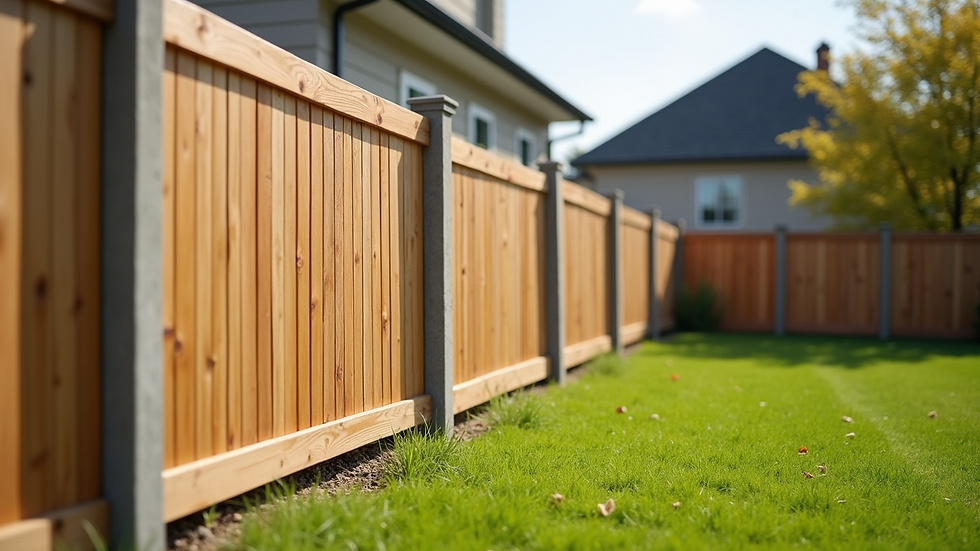Essential Guide to Fencing Supplies for First-Time Installers What You Need to Know
- David Michell
- Jun 25
- 4 min read
Installing a fence can seem overwhelming for first-time installers. From selecting the right materials to understanding the necessary tools, there’s a lot to navigate. However, with the right guidance, this task can become manageable. This essential guide will provide you with all the information needed to complete your fencing project with confidence.
Understanding Your Fencing Needs
Before you buy any supplies, take the time to evaluate your specific fencing needs. Start by thinking about the purpose of the fence:
Are you looking for privacy?
Do you need it for safety?
Or do you want it primarily for aesthetic appeal?
For example, if you want privacy, you might choose a taller fence or a solid panel design. If you aim for safety around a pool, consider a fence that meets local building codes and is at least four feet high.
Next, think about your style preference. Will you opt for a traditional picket fence, a tall privacy fence, or something ornate? Understanding these elements early on will simplify your material and design choices.
Selecting the Right Materials
When it comes to materials, quality is vital. Here are several common fencing materials along with their advantages and disadvantages:
Wooden Fencing Posts
Wooden posts offer a classic aesthetic and blend well with many landscapes. However, they need regular maintenance, such as staining every few years, to prevent rot.
Concrete Posts
Concrete posts are incredibly durable and can last up to 30 years without significant wear. They are perfect for high-security fences but may be pricier upfront compared to wood.
Fence Panels
Fence panels come in wood, vinyl, and metal. For example, wooden panels are traditional but may last 10-15 years, while vinyl panels can last over 25 years with minimal upkeep. Metal panels often provide the highest durability, resisting rust and wear effectively.
Concrete Gravel Boards
These at the base of wooden fences act as a protective barrier against moisture, helping to prolong the lifespan of the wood. Using gravel boards can increase your fence's durability by as much as 20%.
Railway Sleepers
For a rustic look, railway sleepers can create unique garden borders or seating. They harmonize with garden styles, adding charm and visual interest.
Gathering Your Fencing Supplies
Once you clearly understand your fencing needs and materials, it's time to gather your supplies. Key components typically include:
Fence Posts: Calculate the number needed based on your fence length and height. For instance, if your fence is 100 feet long, you may need at least 8-10 posts, spaced every 6-8 feet.
Concrete or Gravel Boards: Choose between concrete for durability or wooden boards, depending on your installation needs.
Fencing Panels: Ensure the panels are compatible with your posts for a secure fit.
Post Supports: In areas with strong winds, additional supports can increase stability.
Tools: Essential tools include a measuring tape, level, drill, and hammer.
Shopping for Fencing Supplies
When you shop for supplies, source from reputable suppliers. This ensures the quality and durability of your materials. Look at customer reviews and talk to friends or family who have fencing experience to find local suppliers.
It can be beneficial to visit multiple stores to compare prices and materials. Remember, the lowest price does not always guarantee the best value, especially with fencing.
Installation Process: Step-by-Step
Understanding the installation process is critical. Here’s a straightforward guide to help you get started:
Planning Your Layout: Measure your yard and mark the positions for the fence posts. This will help you visualize the final result.
Digging Post Holes: Use a post hole digger. Aim for a depth of at least one-third the height of your post. If your post is 6 feet tall, the hole should be about 2 feet deep.
Setting Fence Posts: Place the posts in their holes, making sure they are level and upright. Use concrete for extra stability, especially for concrete posts.
Attaching Fence Panels: After your posts are set, attach the panels according to the manufacturer's instructions. Make sure they are level for a neat appearance.
Final Touches: If needed, add gravel boards and treat any wood panels to enhance their longevity.

Maintenance Tips
Your work doesn’t end with installation. Regular maintenance is crucial for keeping your fence in great condition. Here are some essential tips:
Wooden Fences: Check regularly for rot or damage. Treating them with protective coatings every couple of years can extend their life.
Concrete Fences: Look for cracks in your posts. Sealing them can help, especially in damp areas, adding years to their lifespan.
General Care: Keep the fence clear of debris and plants that can invite pests or moisture.
Wrapping Up Your Fencing Project
Installing a fence for the first time can be an enjoyable experience with the right planning and guidance. By understanding your needs, selecting the right materials, gathering necessary supplies, and following a clear installation process, you can create a beautiful, functional fence that enhances your property. Plus, staying on top of maintenance will extend the life of your fence significantly. With this guide, you're now ready to take on your fencing project. Good luck!


댓글